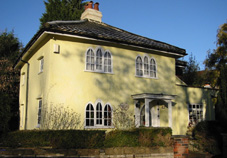
BECKENHAM ESTATES
|
|
| london-footprints.co.uk |
WALKING ROUTE
From West Wickham Station. Red Lodge Road across golf course. Hawksbrook Lane past schools. South Eden Park Road past sites & remains of Victorian houses. At Creswell Drive northwards through Harvington Estate. Exit via Manor Way and right at Stone Park Avenue. Northwards through Kelsey Park (choice of routes). Kelsey Park Road to High Street.
LANGLEY
In 1775 the road passing Langley Park and Langley Farm was diverted (by Amy Burrell) to form South Eden Park Road. On the death of Sir Peter Burrell IV (Amy’s grandson) in 1820 the Langley estate of 3202 acres was sold in 92 lots. Langley Farm with house, offices, coach house, stables & lodge was bought by the Goodhart family. There was also a thatched cottage, used as a chapel. In 1884 JL Bucknall, a shipping magnate, bought the estate and replaced the farm house with Langley Court (in 1886). The Wellcome Foundation Laboratories took over the estate in 1920. Some land was given to the school for sports fields. In 1999 part of the area was developed as Langley Park. Houses are set among parkland to which the public have no access. The original mansion was divided with a single large house and seven apartments in the east wing.
The last owner of Langley Park (Emmamuel Goodhart’s son) died in 1903 and the unoccupied house fell into disrepair. The estate was sold in 1904 for development. Park Langley golf course was created in 1910 and the old mansion was used as a clubhouse until gutted by fire in 1913. Beckenham Grammar School for Girls (now Langley Park Girls’ School) was built on the site of the mansion in 1958.
KELSEY
The first Peter Burrell (of 4) acquired the estate in 1690. A mansion was built for Elizabeth Burrell in the 1760s with a driveway from Kelsey Square. The River Beck was used to form the ornamental lakes, trees were planted and an ice well constructed.
In 1835 the estate was sold to the Hoare (banking family) who converted the house to a Scottish baronial style mansion and added two lodges. A chapel designed by Sir George Gilbert Scott was added in the Victorian period. The house was used as a convent (1895-1901) and school (1901-1909). The estate was due to be sold for development but after a vigorous campaign was purchased by the local council in 1911. A new park keeper’s lodge was built and the park was opened to the public in 1913. During WWI the house was used for military purposes and was demolished in 1921. The attractive 18th century Bailiff’s Cottage (pictured in header) remains in Manor Way plus the two lodges (Kelsey Square and near Park Langley shops) together with former employees’ houses in Kelsey Square.
HARVINGTON
Two large houses were built around 1834 on land belonging to Eden Farm. Eden Cottage (later Manor) with its coach house was on the site now covered by new houses (Hampstead Mews). It was bought by Charles Hoare of Kelsey. Across the River Beck was Eden Lodge. After WWI the properties were used as rest homes for shell-shocked soldiers.
Further houses with stables and lodges were built
along South Eden Park Road 1871-74. North to south they were:
Harvington (1871), Homewood, Chalfont, Oakfield and Elderslie.
The houses had no piped water but water from local springs was
stored in water towers.
Harvington was described as an imposing red brick house with a
slated roof, roughly square in shape with a frontage of sixty
feet. A billiards room had been added but it suffered some
damage when a V2 fell near St John’s church across the
fields.
Homewood and Chalfont, were of white brick and the different lodges reflect the styles of the houses. Oakfield (the only one remaining) was described in 1904 as a picturesque building in Italian villa style. It was constructed of Staffordshire bricks with ornamental stone dressings and mouldings.
The Petley family named Harvington house and estate after their home in Worcestershire in 1919 and set up a dairy farm. When Bertrand died in 1930, Florence gave the land for St John’s Church and bought Homewood & Chalfont to extend the farm. During the war she leased these properties to the Metropolitan Electric Light and Power Company for their offices.
In 1946 Florence was forced to sell land in Eden Park Avenue for the construction of pre-fabs. These were vacated between October 1967 and July 1968 having doubled their proposed life span of ten years. In their place were built old people’s flats and two and three bedroomed houses. When Florence died later in 1946 aged 73, Beckenham Council bought the 37 acres of land for 36,000. This included the area used for allotments between Chalfont and Oakfield Houses. In 1953 Eden Manor was bought by the council for use by the Civil Defence, Guides & Brownies but in 1963 this house and Eden Lodge were demolished as unsafe. The coach house of the former and lodge of the latter were retained. The houses of Harvington, Homewood and Chalfont were leased to the LEB for ten years from 1948. When these leases expired, the lodges continued as rented accommodation for the Park’s staff but the houses were demolished in 1960. An avenue of oak trees was planted to celebrate the Queen’s coronation in 1953. A row of pine trees marks the former drive of Eden Lodge.
Resources:
Beck Corridor walk pack [website]
Beckenham History website
Harvington Estate (London Gardens Online database)
Langley Park Residents Association [website]
Friends of Kelsey Park (inc history page) [website]
Old OS Maps online [website]
london-footprints.co.uk 2013
artbeckestates